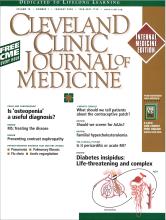Table of Contents
From the Editor
- Abdominal aortic aneurysms: What we don’t seek, we won’t find
We don’t find abdominal aortic aneurysms as often as we should. In some patients we should consider ultrasonographic screening.
Review
- Should we screen for abdominal aortic aneurysms?
The short answer is yes, but only in the right patients.
1-Minute Consult
- What is osteopenia, and what should be done about it?
Because the term “osteopenia” is not useful as a diagnosis and can actually be harmful, I am on a personal crusade to eliminate it from the bone density lexicon.
Editorial
- In rebuttal: Osteopenia is a useful diagnosis
Eliminating the term “osteopenia” would foster complacency and a do-nothing attitude toward a serious and common disease.
1-Minute Consult
- How should we advise patients about the contraceptive patch, given the FDA warning?
In theory, patients could face a higher risk of thromboembolism than with oral contraceptives. But most of all we want to urge them not to simply stop using contraception.
The Clinical Picture
- Severe chest pain in a 32-year-old man
His electrocardiogram shows ST-segment elevation in leads I, II, aVF, and V5 and V6, but no reciprocal changes. What is the diagnosis?
Review
- Familial hypercholesterolemia: A challenge of diagnosis and therapy
Many people have high cholesterol, but a distinct minority have extremely high levels due to genetic defects in lipoprotein metabolism. They need our special attention.
- Diabetes insipidus: Diagnosis and treatment of a complex disease
Diabetes insipidus can be life-threatening, and the treatment depends on the cause in the individual patient.
- Contrast-induced nephropathy: How it develops, how to prevent it
The evidence and our recommendations for using hydration, N-acetylcysteine, sodium bicarbonate, theophylline, and hemofiltration.
- Multiple sclerosis: Advances in understanding, diagnosing, and treating the underlying disease
In spite of setbacks, the future holds hope for patients and clinicians struggling against this disease.




